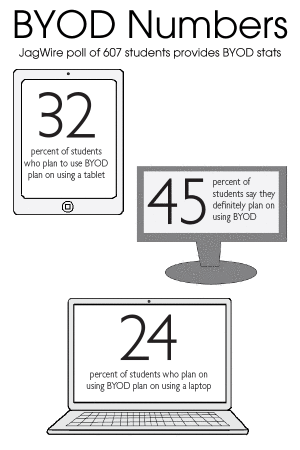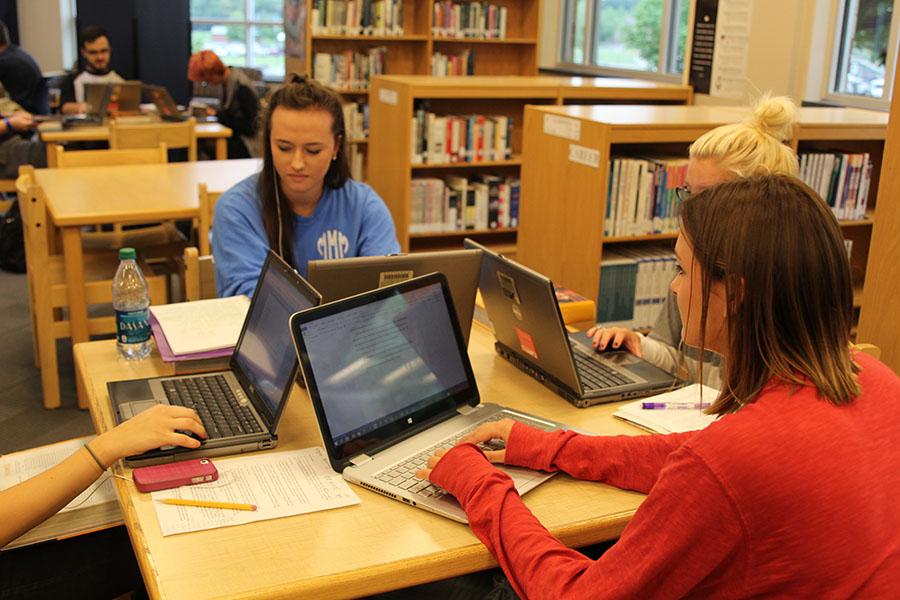District technology changes introduce Bring Your Own Device policy
School embraces changes in technology, including Bring Your Own Device and building wireless upgrade
September 18, 2014
The Bring Your Own Device policy, or BYOD, allows students to use their own electronic device, such as a laptop or tablet, in the classroom. The Department of Teaching and Learning suggested the plan to the Board in May 2013 after a survey of district patrons responded positively to the idea. The plan was accepted by the Board the same month, and the actual policies were accepted and drafted in spring 2014.
BYOD will allow the District Technology Committee time to decide what new technology to purchase, associate principal Leah Vomhof said.
“Some say this is a way for the district to not buy new technology, but that’s not true,” Vomhof said. “It gives us time to research and develop a plan that provides access to devices district-wide, and also make a replacement plan. The problem with laptops now is they’re old and there was no plan when we bought them to replace them.”
The previous wireless system could not support all teacher and student usage at once, so in order to put BYOD into effect, the building was rewired, installing a newer and stronger Wi-Fi system. Vomhof said “we should see an improvement in our overall wireless quality.”
Senior Jessica Clark said the new policy will benefit most students. 
“[In a class] we were setting up Blackboard,” Clark said. “I was doing the same thing on my phone and the computer at the same time, and my phone got there first. I think a majority of students have better technology at home that they’d be able to use here for their benefit.”
Junior Brian Fitzsimmons said BYOD will help him because he will not need to rely on the Portal.
“I don’t have to use the Portal as much because I can just type my document on Word and bring it home and work on it,” Fitzsimmons said. “The Portal doesn’t connect at my house very well so I’ve lost a document before. It’s sometimes very slow or glitchy.”
Senior Luke Rachwal, who uses his tablet to take notes, said BYOD allows students to use devices they’re more familiar with.
“I think it’s a great opportunity because it lets people use technology that they are comfortable with,” Rachwal said. “It just helps that you know what you are doing.”
Vomhof said learning how to use a device that one is comfortable with for educational purposes will be helpful in the future.
“At college, you bring your own device,” Vomhof said. “It’s another way to help students in that transition. It helps students find out what device helps them learn best.”
World languages teacher Edith Paredes incorporates BYOD into her lessons through online testing and extra credit prompts answered by emails to her via a device.
“I like the fact that students have access to more technology and that they can bring them in,” Paredes said. “It’s up to date … I think kids learn better that way.”
Paredes said she has also had some rough times having to reserve laptop carts early for testing or for using online resources.
“If they have their own device, I can say, ‘let’s just go to the online textbook and check this out’ instead of planning weeks ahead to get a laptop cart,” Paredes said.
Sophomore Emma Hansen, on the other hand, said BYOD could result in a bad situation if a student can’t bring a device.
“I think it’s good in some ways, but then in other ways I don’t think they thought it through as much as they could have,” Hansen said. “For some students, they don’t have access to a computer or tablet or a phone. Then some … classes are going to have to end up requiring us to have something … when we don’t.”
While students and staff get used to the changes, the District Technology Committee will be planning Year Three of the technology budget. They started meeting last fall, and members have discussed such questions as what kind of equipment to buy, what the student to computer ratio should be and how to use technology in the classroom.
Director of Teaching and Learning Jessica Dain said the committee, which suggested the BYOD plan, believes that the new policy will be helpful for students and the district.
“The committee is supportive of BYOD,” Dain said via email. “It allows the district to be fiscally responsible while opening the opportunity for more students to have their personal and preferred devices in use at school.”
Vomhof said learning through your own device is a skill that will be invaluable throughout life.
“I know we always say students know more about tech than we do, but do they know how to learn from it?” Vomhof said. “We prepare students for a career or college … but in high school they’ll have enough exposure using tech to be familiar with a device and know how to learn from it.”









